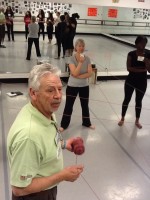The Central Arizona-Phoenix (CAP) LTER’s Ecology Explorers program has begun a collaboration with Arizona State University’s Herberger Institute for Design and the Arts on an exciting new youth project that blurs the boundary between ecological science and humanities. The multi-disciplinary performance initiative, “At Home in the Desert: Youth Engagement and Place,” is funded by the National Endowment for the Arts and Arizona State University’s Institute for Humanities Research.
During the pilot phase of this initiative, Ecology Explorers teacher consultant, John Dole, worked with dance students at South Mountain High School as they explored the desert ecology to create a “moving field guide” that will be performed at venues in the Phoenix area. Dole, a former high school ecology teacher, introduced students to geophysical concepts of how deserts form, how organisms have evolved to survive in these harsh climates, and the urban ecology of the greater Phoenix area.
The students then created a three dimensional “web of life” to explore how organisms are interrelated in the urban Sonoran desert ecosystem. Feedback from the students indicates that they have retained some powerful images of the desert that they will later incorporate into dance. These images include “a field of poppies,” “thirty year-old saguaros,” “nocturnal animals that hunt at night,” and “how plants retain water to survive.”
The next phase of the project will involve Girl Scout troops working with the high school dancers to create movements interpreted from desert ecology, which will be videotaped and shared online as part of a national program led by the Liz Lerman Dance Exchange. Future collaboration with the “At Home in the Desert” initiative may involve Dole working with hip hop artists and students from local Boys and Girls Clubs to explore desert metaphors through hip hop.

 Enlarge this image
Enlarge this image